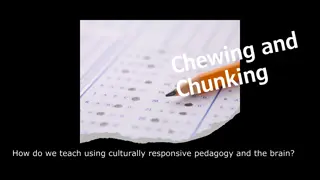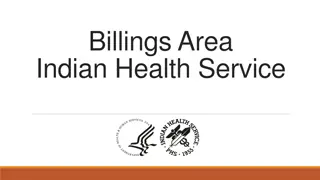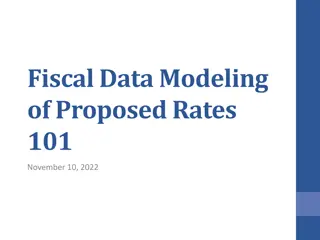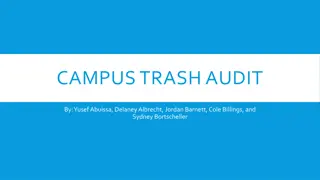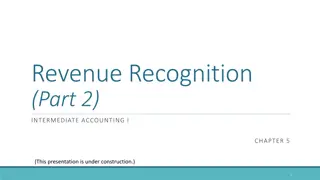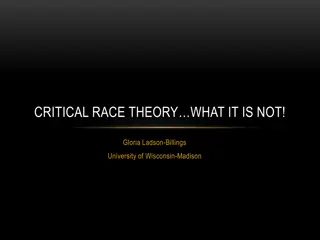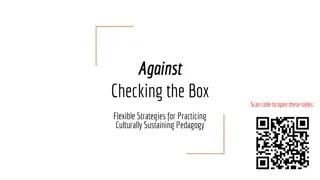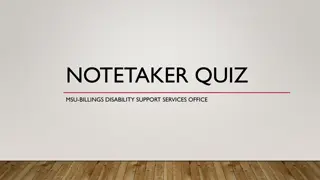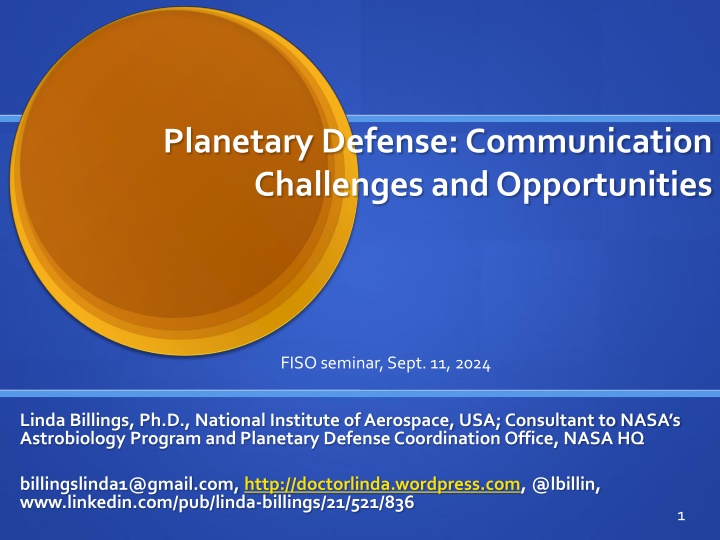
Challenges and Opportunities in Planetary Defense Communication
Explore insights on the practical, social, and symbolic aspects of communication in planetary defense, highlighting risks, hazards, and threats posed by near-Earth objects. Learn about the significance of effectively communicating these dangers to the public to ensure preparedness.
Download Presentation

Please find below an Image/Link to download the presentation.
The content on the website is provided AS IS for your information and personal use only. It may not be sold, licensed, or shared on other websites without obtaining consent from the author. If you encounter any issues during the download, it is possible that the publisher has removed the file from their server.
You are allowed to download the files provided on this website for personal or commercial use, subject to the condition that they are used lawfully. All files are the property of their respective owners.
The content on the website is provided AS IS for your information and personal use only. It may not be sold, licensed, or shared on other websites without obtaining consent from the author.
E N D
Presentation Transcript
Planetary Defense: Communication Challenges and Opportunities FISO seminar, Sept. 11, 2024 Linda Billings, Ph.D., National Institute of Aerospace, USA; Consultant to NASA s Astrobiology Program and Planetary Defense Coordination Office, NASA HQ billingslinda1@gmail.com, http://doctorlinda.wordpress.com, @lbillin, www.linkedin.com/pub/linda-billings/21/521/836 1
Communication is Practical action Social action Symbolic action 2
Insights from research and practice Communication is contextual, contingent, situated, and symbolic as well as instrumental. The public is not a monolithic audience. Mass media and, increasingly, social media play a key role in public discourse about science. The professional values and practices that journalists and scientists employ are different and sometimes conflicting. Facts, truth, knowledge . 3
Risks, hazards, and threats Hazard: potential to cause harm Risk: assessment of probability and extent of harm Threat: a declaration of an intention or determination to inflict punishment, injury, etc., in retaliation for, or conditionally upon , some action or course. (Asteroid, near-Earth asteroid, near-Earth object, potentially hazardous asteroid, meteor, bolide, meteoroid, meteorite .) 4
Framing the hazard of NEO impacts with Earth NEOs smaller than 8-10 miles in diameter would not destroy Earth but could lead to "the breakdown of civilization" (Morrison 2003) Lifetime risk of being killed by an asteroid: 1 in 50,000 (DM/CC) NEOs as "serious threats, "dangerous objects" (NASA press release, workshop on NEO reconnaissance and exploration, September 3-6, 2002) Forget about Richter scales, Torino scales, Palermo scales. What people want to know is, Am I at risk and, if so, what is that risk?" (Seth Borenstein, AP, NASA workshop, 2002) "The total risk (measured by equivalent annual fatalities) for all impacts below the threshold for global disaster is at least a factor of 100 below that associated with global disasters, assuming that the threshold for global disaster is between 1 and 2 km diameter (roughly 1 million megatons...)." (Morrison in NASA Ames press release, March 17, 2003). 5
NRC 2010 Committee to Review Near Earth Object Surveys and Hazard Mitigation Strategies (NRC 2010): The statistical risk to human life and property associated with impacts of [asteroids] is real, but it falls outside the everyday experience of most of humanity. This risk must therefore be communicated effectively to the community at large in the context of other natural disasters, particularly those that the local community is likely to encounter. Scientists must carefully assess and explain the hazard so that appropriate public policy measures, commensurate with the level of risk, can be put into action. There must be an assessment of the statistical risk from [asteroids] that is reasonable and acceptable to the general public. 6
More history SWF-ASE workshop, NEO risk communication, 2011 (SWF report, NEO Media/Risk Communications Working Group Report , June 2012) House Science Committee hearing, March 2013 Planetary Defense Conference, March 2013 (Flagstaff) B612-ASE media event, fall 2013 (NYC) IAWN Steering Committee first meeting, January 2014 IAWN communication workshop, September 2014 NASA-FEMA TTXs 2013, 2014, 2016, 2020, 2022, 2024 7
SWF-ASE NEO communication workshop, 2011 Make use of the findings of experts in risk communication in designing its communication strategy. From the beginning, the network should include skilled communicators supported by risk analysts, planners, scientists, psychologists, emergency management experts and other functional experts. 8
NASA-FEMA TTX #1, April 3, 2013 Improve tools for communications on the nature and evolution of NEO threats to make it more clear to the public and decision makers how an actual threat might evolve. Technical terms such as Monte Carlo should be clearly defined. The uncertainty and level of risk need to be made clear to the public and to decision makers using metrics and diagrams that can be readily understood . The current scales that rate potential threats might be useful to experts, but [are] difficult for the public to understand. A simpler system should be considered for informing the public. 9
PDC 2013 white paper Observations and recommendations relating to communication across expert-non-expert boundaries what we need: Expanded efforts in communication. Characterization of impact hazards, risks, and effects in ways that are meaningful to decision makers and other non-experts. A clear international chain of command for dealing with NEO risk and a communication strategy that makes use of findings from experts in communication. Open and transparent communication of information about NEO hazards. A common language to characterize NEO hazards and impact mitigation options. 10
IAWN communication workshop, September 2014 The fundamental principles of risk communication are well defined and widely embraced. IAWN can draw on these principles in developing its communication strategy and plans. Cultivating and maintaining public trust, issuing notifications and warnings in a timely fashion, maintaining transparency in communications, understanding its various audiences, and planning for a range of scenarios are important to effectively communicate NEO impact hazards and risks. IAWN needs to operate as a global, round-the-clock communications network in order to become a trusted and credible source of information. Quantitative and probabilistic scales are of limited value when communicating with non-expert audiences. Qualitative measures of characterizing impact hazards and risks and describing potential impact effects may be more effective communication tools. 12
Communication style For science: Be clear, concise, correct - and timely. (jargon, numbers, probabilities, scales ) In the current environment: be open and transparent. Truly engage . 13
PHAs (and PHOs) Apophis (99942 Apophis (provisional designation 2004 MN4) has been deemed a potentially hazardous asteroid. We need to explain why we are using this designation, what it means, and what it does not. IAWN: while the term potentially hazardous asteroid (PHA, or potentially hazardous object, PHO) carries with it a bit of sinister connotation, the truth is nearly all objects in this category are not 'hazardous' at all!... The definition [of PHA] does not actually indicate if these objects have possible impacts in the future. This is simply a means of identifying objects that are of sufficient size and capable of making close approaches to the Earth. What does capable mean here? 14
Language! Tidal torque MOID Geocentric distance Ecliptic plane Spin state Etc. 15
More language Avoid subjective terms or explain what they mean to you. Important to whom, and why? Significant to whom, and why? Serious ditto. Etc. 16
Numbers can mislead Probability does not equal odds. Probabilities are couched in uncertainty. Correlation does not equal cause. Fewer numbers and more words = greater clarity. Avoid fruit picking the selective presentation of data to convey a false impression of unassailability. Cherry picking : highlighting data that support an argument and ignoring data that don t. Apple polishing dramatized rather than accurate graphic representations of data. Minor changes in wording can easily make a huge risk seem worth taking or an insignificant risk seem dangerous. (See the work of Kahneman and Tversky.) (Charles Seife, Proofiness: The Dark Arts of Mathematical Deception, Viking, New York, 2010.) 17
Communicating uncertainty about facts, numbers, and science A.M. van der Bles et al, 2019, Royal Society Open Science, royalsocietypublishing.org/journal/rsos: We identify three objects of uncertainty facts, numbers, and science - and two levels of uncertainty: direct and indirect. The effects of uncertainty communication on cognition, emotion, trust and behaviour in economics statistics appear not to have been studied. Whereas several studies have shown that uncertainty communication can affect people s affective responses and trust, more research is needed to understand under what conditions these effects can be positive or negative. To our knowledge, no systematic empirical research has been conducted about the effects of epistemic uncertainty communication on behaviour and decision-making. 18
Apophis: It wont hit us. We all know this. The 2029 close approach provides an opportunity to explain WHY and HOW we know Apophis won t hit us. Remember the scene in Don t Look Up scientists don t like to say that anything is 100% percent certain. But we need to be ready to explain how certain we are about this close approach (and why we can t say 100 percent ). 20
A rare natural event This description of the close approach of Apophis is more relatable, IMHO, than the natural experiment designation. Can we compare this rare natural event to others? Such as a comet appearance? Once in a thousand years? How do we know this? 21
Inverse, October 9, 2023 NASA Redirected Its Asteroid Mission To This Menacing Object Near Earth Apophis is an asteroid with a loathsome name . Apophis once sourced an existential fear: a violent asteroid impact in 2029. Now, though, current predictions say that s barely a remote possibility. The asteroid will not strike Earth this century, but it will come intriguingly close. Earth.com, Jan. 10, 2024: God of Darkness asteroid Apophis 22
Whats in place National Near-Earth Object Preparedness Strategy and Action Plan (OSTP, 2018) Report on Near-Earth Object Impact Threat Emergency Protocols (NSTC, 2021) NPD 8740.1, Notification and Communications Regarding Potential Near-Earth Object Threats (2017-2027) The International Asteroid Warning Network (iawn.net, 2014) 23
Where are we now? NASA s Planetary Defense Coordination Office (PDCO) has an agency strategy in place: NASA Planetary Defense Strategy and Action Plan (2023) PDCO is working on an updated communication strategy. NASA is also in the early stages of discussions about communication planning for the close approach of Apophis in 2029. 24
My suggestions A common communication strategy A common language/vocabulary Common messaging Scholar-practitioner collaboration (Research informs practice, practice informs research) 25
And just a reminder. Hazard: potential to cause harm (asteroids are inanimate objects) Risk: assessment of probability and extent of harm Threat: adeclarationof an intention or determinationto inflict punishment,in jury, etc., in retaliation for, or conditionallyupon, some action or course. And let s use the IAU-approved definitions for: Asteroid, near-Earth asteroid, near-Earth object, potentially hazardous asteroid, meteor, bolide, meteoroid, meteorite . 26

